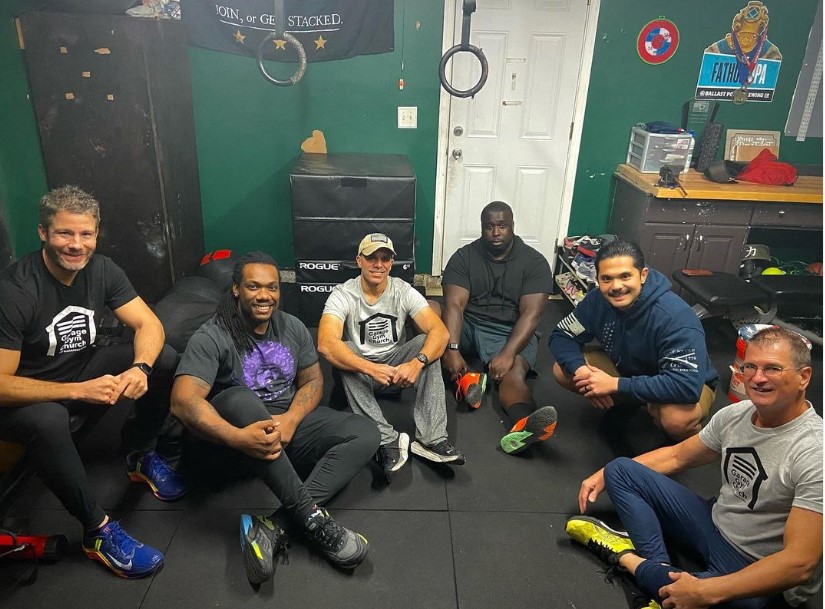My blog is focused on the innovative Garage Gym Church construct being pioneered between Faith & Fitness Magazine and Freedom Fitness America. I integrate physical fitness with spiritual, mental, and social fitness training based on lessons learned in implementing this approach inside the military community. Through 16+ years of active duty US Marine Corps service I’ve supported chaplains and non-profit organizations in new concepts of spiritual and mental toughness lifestyle training for military professionals. Along with that I developed options for Christian outreach and training concepts. – Chris Reardon, Founder/Executive Director of Freedom Fitness America
In America, pastors and church leaders often ask congregants to invite friends and family to church. It’s basic outreach in line with the Biblical mandate to go and make disciples of Jesus. (Matthew 28:16-20) Churches have special events during Christian holidays like Christmas and Easter when people may be more inclined to attend a church service. The “Easter Weekend” is known as the “Super Bowl” time for churches to reach people. Some churches get creative and offer sunrise services in outdoor environments. It’s a word-of-mouth approach for church growth versus other forms of marketing media and outreach techniques.
While the approach mentioned above may seem to be an effective church growth strategy in reaching the lost, there is a growing body of evidence in North America that says this strategy is not working as well as once thought. In particular, Dr. Rice Brooks, a pastor and evangelist to college campuses
around the world writes in his doctoral dissertation “The Evangelist” the following:
“It became clear to me that the church-at-large in North America was losing the ability to reach lost people and that much of what was called “church growth” was in reality “transfer growth” or a migration of Christians from one church to the next.” He also writes “Many church growth strategies seem to paint outreach as merely reaching out to people as potential customers by providing a better church experience than the church down the street, rather than focusing on the biblical mandate to “make disciples” through new converts.” (The Evangelist, Dr. Rice Brooks, pg. 17)
In my 18 years of being a Christian, I have seen what Dr. Brooks states above to be true both in churches I have visited around America and with Christian para-church ministries designed to reach out to unique demographics. While churches and ministries say they want to reach all people in theory, in practice, the focus, unfortunately, becomes a “circle the wagon mentality” of exclusively recruiting Christians who are moving into the geographical area as others move out in terms of either growing or maintaining church and Christian fellowship numbers.
My experience as well has been that Christian individuals inside of these circles often do not regularly attempt to share their faith with friends, neighbors, and co-workers who are not Christians. This is unfortunate because it has been seen in practice that most people come to faith either as children from the example of their parents or through a genuine relationship with a Christian friend or relative. One church growth research found that “75-90% of people come to faith in Christ through a friend or relative.” (Gary McIntosh, “What Person Led You to Faith in Christ”, October 29, 2014) It stands to reason then that the problem so many churches are not growing from evangelism efforts is that churches have not equipped everyday people to share their faith and be part of the Great Commission where they work, live, and play.
Exploring the reason why everyday Christian people struggle to share their faith with those who are not of the Christian faith, especially in North America, is based on a lot of sub-cultural thinking patterns or beliefs that are unwritten but often publicly stated even where there is a political practice of the freedom of speech and public religious expression and worship without direct government interference which may be the case in Asia, Europe, and the Middle East.
One of those thinking patterns an everyday Christian can struggle with is to be perceived as “shoving their religion down another’s throat” with co-workers, friends, and family members if they invite somebody to a Christian message, prayer meeting, concert/worship service, or speak about their faith in public forums whether in social media, social settings, or in official events. It is often seen in North American culture today that to talk about religious convictions with people of another faith group or none at all is impolite conversation.
Church training in this matter often doesn’t help either because outreach efforts for the Christian faith are typically focused on strangers during overseas mission trips, local visitations, street/beach evangelism, homeless outreach, or community events. Here Christians find it easier to share their faith boldly without fear of rejection because they are often talking to complete strangers they likely never have to see again and don’t have to worry about offending because the practical relational consequences are minimal.
Conversely, talking to friends, family, co-workers, bosses, and other members of your regular professional and personal life whom you share a practical and emotional social need for a long-term relationship with makes these exchanges harder. If as a Christian you are rejected socially for what you believe when you share your faith, it is likely you feel awkward around these individuals in the future. As a consequence of this real or imagined fear of being seen as an outsider socially in whatever circle that may be, many Christians opt out of participating in sharing their faith where they live, work, and play which as I stated before is ironically where they have the most influence and statistical opportunity to help fellow human beings come into an intimate relationship with their Creator who is poised to meet all of their needs physically, spiritually, and socially.
Garage Gym Church: Missional Culture for Everyday People
Garage Gym Church is a place where fitness-oriented individuals who are Christian believers can intentionally create a setting of social community through intentional physical activity among neighbors, co-workers, friends, and family right inside their own homes. Inviting somebody you know to participate in a physical fitness activity, especially in a home is logistically easy (you own the garage or somebody else does!) and invites a sense of warmth and genuine relationship vs. a sense of a forced agenda that could come from inviting somebody to an overtly religious setting such as a Sunday church service. It also allows for a regular time of bonding through physical training and suffering with a natural time, especially after the workout for a deeper conversation with openness of spirit because your mind and body are tired with the natural tendency to want to rest and bond for a little bit before moving on to the next activity of the day. So how does a Christian fitness enthusiast practically create a regular fitness group out of their home garage that offers the opportunity for a missional church model? Here’s how:
Step 1: Physical Training Session Design
Come up with a workout that can be done logistically with the equipment you already have. Bodyweight workouts can be very effective if you don’t have bumper plates, barbells, sandbags, etc. Furthermore, you will want to create a workout that allows for participants to rotate in and out of equipment stations in various areas of your garage or driveway which can include partner or team workouts that split repetitions and sets. One place I like to go for workouts that are challenging but lead to a team-building spirit is CrossFit Hero Workouts of the Day which uses both equipment and bodyweight and is done in honor of military, police, and firefighters who have died in the line of duty. Reading off the citation of who the workout is done in honor of with symbolism given to the repetitions, sets, and exercises sets the table mentally and spiritually to remind oneself of the importance of living for a greater cause in service of others and being willing to lay down one’s life for one’s friends as Jesus mentioned before He Himself gave His life up (John 15:13). Typically given time constraints for the vast majority of people while also considering that most people are not dedicated athletes, you will want to keep the total fitness training time for starters to 45 minutes including a 15 minute warmup period to allow for “church” time.
Step 2: Initiate Comraderie
To initiate camaraderie, invite a Christian friend who is interested in fitness to come join you in your garage to work out and bond with a stated opportunity for Christian growth leveraging prayer and relevant curriculum content for discussion after the workout. Furthermore, have you and your friend plan to invite 1-2 friends each who may or may not be Christians to join you for the workout at a minimum with the opportunity to join you both afterward for the content discussion centered around a relevant life topic the Bible addresses. You will want to also come up with a music playlist that is fun to train too while also setting the stage for future conversations about God such as Christian rock/metal/rap such as Skillet through a Bluetooth speaker while not coming across as too churchy with worship music. The speaker I like to use that has clear sound quality, is relatively inexpensive, dummy proof to use, lightweight, waterproof, and can be linked with other speakers is the JBL Charge 5.
It is generally difficult to have more than 6 people in this type of session if you include the use of a driveway with typical numbers being 2-4 people especially when you will want to just use the garage on colder or rainy days. We’ll discuss in a future blog how to create more “Garage Gym Church” sessions out of your garage and others, but for now, start small with inviting at least one other Christian friend and both of you choosing to invite a friend. This is a very easy model that sets the stage for keeping the group together in the long haul as people tend to want to spend time with others they naturally know and like. It also demonstrates for the future how easy it is a repeatable format to create their own group.
Lastly, in terms of camaraderie, I have found that allowing space for talking during quick breaks while one person is training is helpful for forming a positive social atmosphere that guys especially will want to come back to again and again.
Step 3: Fireteam Prayer
Prior to any fitness training, have yourself and your Christian friend pray at least 15 minutes prior to the workout warmup starting using the “Fireteam Prayer” concept previously mentioned in another blog on Faith & Fitness Magazine. Having regular prayer sessions for 15-30 minutes is a great way to connect the hearts of the participants to God and create an atmosphere where God moves in the hearts of the community you are with along with your own life!
Step 4: The “Opt-In” Opening to Related Biblical/Christian Content and Discussion
At the conclusion of the fitness training session, the leader will mention something to the effect of, “I’m really glad you came and would love it if you come to train with us the next week (or day). As a supplemental part of this training session, if you would like to stick around, I am going to be having a deeper conversation with [state the name of your Christian friend] to dive deeper into [topic](or another one that is relevant that would be of interest) from a Christian faith perspective”.
Ideally, here you will also incentivize this session by offering coffee, water, food, etc. that will make the person want to stick around. This is a simple but effective component to the overall Garage Gym Church experience as it is hard to turn these down while also allowing a sense of focus on the content being watched or discussed without participants literally thinking about their need to get breakfast, lunch, or dinner for that matter.
What is amazing about this is that nobody feels forced to stay, but rather incentivized through a sense of camaraderie with individuals they just bonded with along with potential food! They also may be interested in the topic and feel this is a good time to learn in an organic setting. At the same time, if they turn you down, there is no real sense of awkwardness because at a minimum those who wanted to participate in the follow-up study will do so as pre-planned and anybody is welcome to continue with a general workout training session as a part of habitual relationship building. It may be multiple sessions for non-Christians to decide to participate in a follow-up discussion let alone be convinced to follow Christ and His teachings, but at least they are now in a setting where they feel they have been befriended and do not feel some sort of bait and switch in terms of a “church experience”.
From a content selection purpose, it should be short and to the point typically with videos no more than 20 minutes with 10-15 minute discussion on relevant life application. I have seen that without food, people tend to lose interest after about 10-15 minutes of watching or listening to some sort of audiovisual content post-workout, especially in the morning before the workday. You will want to typically play the content from a YouTube video or other audiovisual source through the Bluetooth speaker with a follow-up discussion. Good content sources are Above Inspiration, Lion of Judah, March or Die (a military version of Christian leadership content), and Elevation Church. Another option is a series that presents in a systematic format the principles of the Christian faith called Alpha.
The purpose here is to make it clear that the workout content, discussions, and individuals present will be focusing on becoming stronger in their faith. From a Christian life group perspective, especially for men, this is a much more attractive option vs. the traditional “let’s do a Bible study” which comes across as boring to a lot of guys no matter the branding spin a church’s men’s group puts on it.
Bringing it All Together
If you like what you have read here and would like to get a Garage Gym Church going of your own, please pray about the points above and start thinking of starting your own Garage Gym Church session. Consider friends and co-workers whom you can invite, think about their felt needs, come up with content that they would be interested in along with yourself, and then figure out a fitness training plan. Then start inviting people and getting it going! Don’t worry if the numbers are small at first because the model is designed to scale through multiplication meaning eventually the goal is to get your friends, co-workers, and neighbors to do the same thing in their own garage or training space down the road! That is a topic for a future article as well. Consider 30, 60, and 90-day training plans that involve a particular schedule of curriculum, and feel free to share this ahead of time along with the workouts. Also, encourage the participants to bring their friends along too! Furthermore, feel free to email me directly and/or watch a short video on the concept with the link in my signature line below!
Fit for the Fight and Life,
Chris Reardon
Founder/Executive Director
Freedom Fitness America
Email: chris@freedomfitnessamerica.org













